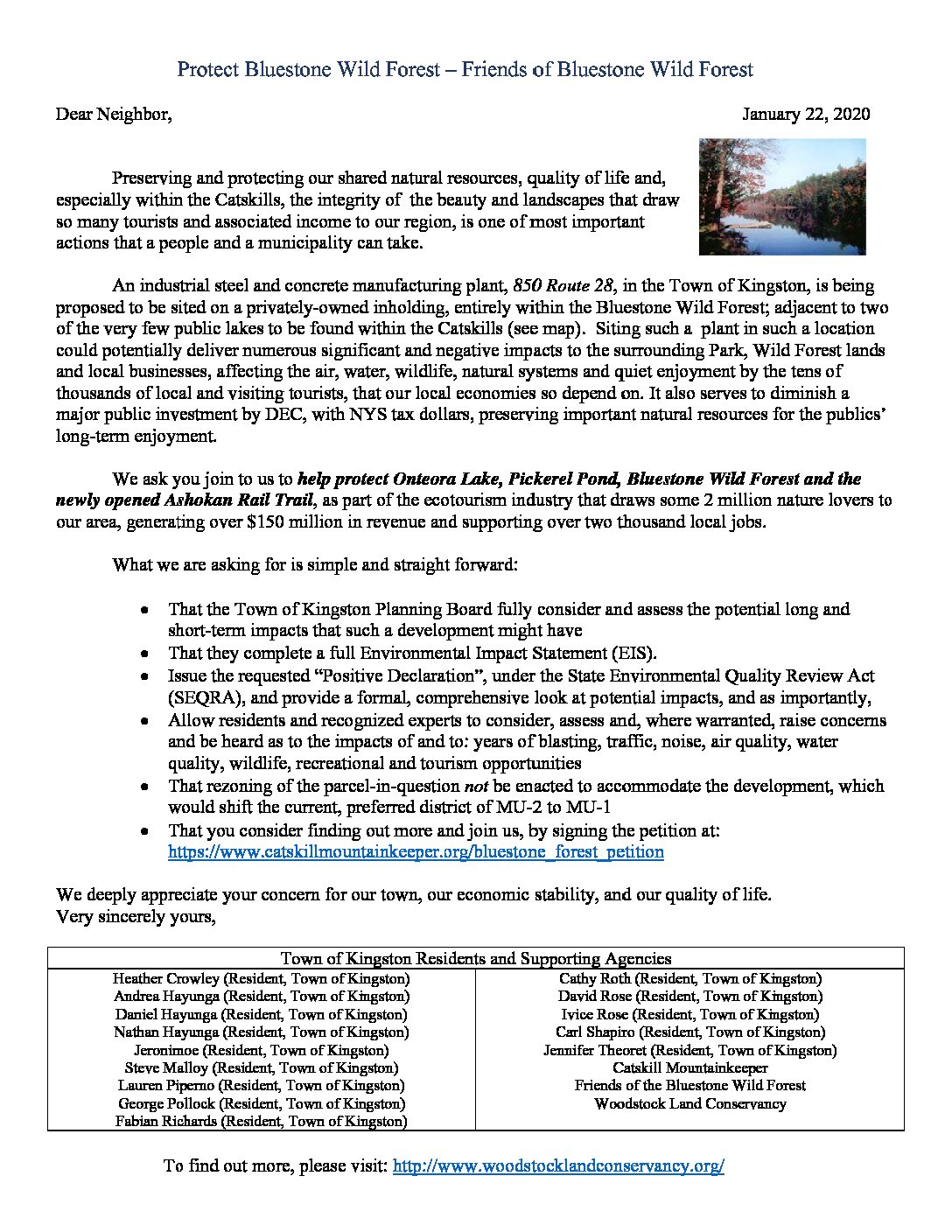Fact Sheet
850 Route 28 Fact Sheet Authored by Woodstock Land Conservancy
FACT SHEET
850 Route 28 LLC’s proposal before the Town of Kingston Planning Board is to construct a large-scale pre-cast concrete and steel manufacturing facility on land surrounded by the Catskill Park’s Bluestone Wild Forest (BWF) including a property conveyed to the State by the Open Space Institute (OSI) in November 2019. The BWF is a beloved natural recreational area with the fully accessible Onteora Lake Day Use Area and multi-use trail system for residents and visitors to hike, bike, fish, swim, boat and enjoy the peace of its woodlands.
In its initial environmental assessment form the applicant failed to identify the BWF’s adjacency and did not measure the project impacts on the BWF. The Town Planning Board had issued a Negative Declaration determination for Environmental Impacts in March, 2019, but with all of the new information brought to it over the summer of 2019 they rescinded this determination in late August 2019. In December 2019 the applicant submitted a revised Environmental Assessment Form which is currently under review by the Town Planning Board and an interested public.
The applicant says that they will protect the environment.
The applicant should prepare a comprehensive Environmental Impact Statement to ensure the project protects BWF and OSI’s lands. Further study is needed for the following impacts:
● Impact: Overview
The project proposes clearing 21 acres of trees, blasting and moving 405,000 cubic yards of rock, and constructing two buildings totaling 240,000 square feet. Project consultants have stated that construction will take four years of work lasting from 6 AM to 7 PM, and nearly 12,500 trucks will be required to remove 162,000 cubic yards of material. The applicant has additionally requested that upon project completion they be permitted to operate 24 hours a day, seven days a week (adding over a hundred new vehicle trips daily onto Route 28 (including 42 heavy equipment trucks with attendant diesel exhaust and emissions)).
● Impacts: Noise
The four-year construction phase will include significant amounts of blasting, rock crushing and other noisy activities that two sets of environmental scientists have now stated will affect recreation and wildlife in the Bluestone Wild Forest. The initial noise impact study did not include sensors on these adjacent lands, nor did it study cumulative combined noise levels from various machinery, equipment and other activities occurring simultaneously at any given time. Subsequent studies are being reviewed. The Planning Board’s Noise Consultant, Change Environmental, and WLC/Catskill Mountainkeeper’s consultant, Barton & Loguidice have additionally issued a detailed report/letter detailing the very severe noise impacts from the project.
● Impacts: Stormwater collection. Water Quality. Water Quantity
The applicant’s stormwater pollution prevention plan continues to raise concerns that contaminants will enter the downstream watercourses, Praymaher Brook (class C Trout stream) and off the driveway into DEC wetlands on the southern edge of Onteora Lake. Additionally, inadequate test well data has been provided for the existing well, and none provided to date for the proposed additional two wells. While the applicant maintains that their water usage is low, this has not been sufficiently detailed and proven, and concerns remain about the sufficiency of the aquifer to provide for this project and other area users.
● Impacts: Traffic
The applicant only analyzed the effects of traffic on Route 28. There is no information regarding the effect of truck pollution and noise on the Bluestone Wild Forest, or to the Waughkonk Road neighbors.
● Impacts: Visual
No thorough analysis of the visual impacts of the construction of a huge manufacturing plant surrounded by the Bluestone Wild Forest. The current Bluestone Wild Forest yellow trail is sufficiently close that it offers glimpses of current on-site activities. Pledges to mitigate visual and aesthetic impacts including by preserving tree buffers are welcome. However, in April 2019 the applicant felled mature trees (authorized in mid-March as part of “limited site-prep” by the Planning Board) in one likely prime buffer zone at the boundary of the project site with NYS DEC lands, suggesting this impact needs additional review.
The applicant said they will be seeking LEED Silver ‘Green” designation.
Applicant has not provided any information from the US Green Building Council indicating that this project could be considered for this designation, nor provided detailed specifics how they intend to meet the standards necessary to qualify.
The applicant says that the project will provide “60 plus well-paying skilled jobs. Many of these full-time, tech positions will be filled from the SUNY Ulster and BOCES trained workforce.”
The promise of jobs is alluring to all of us, but no details have been provided to verify what the 60 people will be doing, and what they will be paid. How many of these will be actual full-time jobs, at what wage rate, and what benefits will be available? Without this information, we can’t be certain that these ‘new jobs’ will be paying a living wage with or without benefits.
By contrast the daily, diverse recreational uses of Onteora Lake and the Bluestone Wild Forest also supports the local economy, but it does so without negative impacts. This economic analysis was absent from the 850 Route 28 application and there has been none offered to the Kingston Planning Board.
It is essential that any projected positive economic benefits of the project not come at the expense of negative impacts on the positive economic, health and ecological benefits deriving from the surrounding public recreational lands and natural resources. This study belongs as part of this review process.
The applicant promises major local tax revenue with “over $363,000 in annual school, town and county taxes are anticipated from our project, representing a 7-9% increase for the Town of Kingston.
The applicant’s statement is misleading and plays on people’s fundamental misunderstanding of how local taxation works, as every property owner pays their proportional share of value to the budget as a whole, whether for school, town or county. A Fiscal Impact Analysis (FIA) has yet to be done in order for there to be a review to confirm the applicant’s claim of annual tax payments. Also, the applicant has made no commitment not to seek tax relief through Ulster County IDA or other means. It is a matter of public knowledge that another company owned by the applicant did in fact apply for over $900,000 in tax exemptions from the Ulster County Industrial Development Agency (IDA). Finally, contrary to recent statements by the applicant’s representatives to the Town of Kingston Planning Board, New York State Department of Environmental Conservation pays taxes on the Bluestone Wild Forest lands.
The applicant says that they will add income to local businesses. “Our employees and company will be patronizing local businesses, adding to the energy and health of our local economy.”
While this may be true, it is already evident that many current users of the Bluestone Wild Forest patronize the area’s local businesses – and with expansion
of the forest, there will be more people patronizing these same stores.
The applicant says that they will make infrastructure for local use fabricating the final pieces required for NYS bridge construction (bridge decking).
The applicant says that its fabrication greatly reduces transportation fuel use by eliminating transport of bridge decks from far away, “what’s made here stays near.” Does that mean the applicant will only supply bridge components for contracts in a specified mile radius, such as 50 miles?
On-site Crane Storage
In 2019 the Kingston Freeman reported the applicant’s disclosure that it had instituted on-site storage of commercial cranes and crane equipment at the 850 Route 28 site. It is our understanding from the news report, as well as a 2020 complaint that the Town ZEO, in consultation with the Town of Kingston Planning Board, has rendered an opinion that this is allowed related to a prior permit issued to the previous owner of the property a decade ago.
Setting aside significant questions regarding whether the new crane or other storage activities are permissible absent a new application and special-use permit, including in light of the fact that the property has been rezoned by the Town twice in the intervening period, what is clear is that storage (including an explanation of how precisely it is an accessory use to the project) was not part of the project application, application materials and site plan reviewed by the Planning Board. This includes requiring the applicant to identify what such storage will entail, whether and where repair work will be conducted, whether and where fuel storage and refueling will occur, ditto for the use of chemical solvents, welding, etc. The appropriate siting, enclosure, containment and disposal measures for all such activities must be identified and reviewed.
The responsible and constructive course of action is for the Town of Kingston Planning Board to issue a Positive Declaration determination and require the developer to examine all potential adverse environmental impacts, as required under the State Environmental Quality Review Act. We reiterate our request that all impacts be assessed and suitable mitigation techniques and alternatives be investigated.
(rev. August, 2020)

